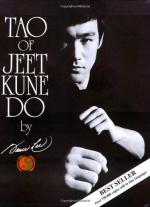
|
| Name: _________________________ | Period: ___________________ |
This test consists of 5 multiple choice questions, 5 short answer questions, and 10 short essay questions.
Multiple Choice Questions
1. What move does Lee teach for forcing the opponent to move to avoid an apparent attack?
(a) The escape.
(b) The counter attack.
(c) The feint.
(d) The parry.
2. What does Lee call the four forms of simple attack that include thrusts, simple disengagements, counter-disengagements and cut-overs?
(a) Renewed attacks.
(b) Compound attacks.
(c) Counter attacks.
(d) The Power Four.
3. A _____ snaps the body from a straight lead to miss an opponent blow.
(a) Duck.
(b) Snap back.
(c) Counter.
(d) Parry.
4. The two parts in a feint are a _____ thrust and a _____ evasive thrust.
(a) False/Real.
(b) Powerful/Weak.
(c) Large/Small.
(d) First/Second.
5. What attack occurs in the same line as the original action when the opponent retreats without a parry?
(a) The delayed.
(b) The original.
(c) The progressive indirect.
(d) The renewed.
Short Answer Questions
1. Where should the execution of the feint start from?
2. What does Lee conclude is based on feints and actions connected to them?
3. What does Lee say requires preliminary analysis, preparation, and execution?
4. What does Lee say a long and deep feint draws the opponent into?
5. Lee states that most offensive action is _____, following a _____ or countering an opponent attack.
Short Essay Questions
1. How does a feint force hesitation while closing the distance?
2. What state of mind should one have when assuming the fighting stance?
3. What happens to previous learning while training in Jeet Kune Do?
4. Lee describes the speed of a simple attack as both "smooth and explosive." How might it be possible to achieve this state?
5. Attack on preparation stops an opponent before the plan is matured. Does this attack requires physical training, mental training or both?
6. What might a fight look like where two fighters have different fighting measures?
7. Based on the teachings in Chapter 6, what do you think is the best strategy for getting an opponent off balance?
8. Why does Lee recommend making economical moves?
9. How does rolling minimize the fighter's punch?
10. Describe Lee's concept of the circle with no circumference.
|
This section contains 710 words (approx. 3 pages at 300 words per page) |

|




